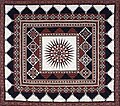English paper piecing: Difference between revisions
PureSkylor (talk | contribs) m The original explanation was confusing and didn't clearly differentiate between the 2 forms of piecing fabric. |
PureSkylor (talk | contribs) m The original explanation was confusing and didn't clearly differentiate between the 2 forms of piecing fabric. |
||
| Line 1: | Line 1: | ||
[[File:English_paper_piecing.jpg|thumb|Star shapes made by paper piecing]] |
[[File:English_paper_piecing.jpg|thumb|Star shapes made by paper piecing]] |
||
English paper piecing is a method of wrapping and stabilizing fabric shapes using thin pieces of cardboard or heavy paper. An iron is used to wrap the seams of the fabric around the carboard shapes. Once the shapes are wrapped and ready, the sewer will hand sew the shapes together one at a time until the shapes become an intricate design. The paper or carboard is removed once the shape has been sewn to another shape on all sides. This is an art for those who like to sew by hand. |
English paper piecing is a method of wrapping and stabilizing fabric shapes using thin pieces of cardboard or heavy paper. An iron is used to wrap the seams of the fabric around the carboard shapes. Once the shapes are wrapped and ready, the sewer will hand sew the shapes together one at a time until the shapes become an intricate design. The paper or carboard is removed once the shape has been sewn to another shape on all sides. This is an art for those who like to sew by hand. |
||
The practice's name comes from the fact that it was, and still is, popular in Britain. The technique used to paper piece involves wrapping paper shapes in fabric and then stitching the fabric together. Once a shape, bloc, rosette, or finished piece has been made, the papers are removed, leaving the fabric as the remaining item. |
|||
English Paper Piecing should not be confused with Foundation Piecing, nor should it's name be shortened to calling it paper piecing. Calling it paper piecing only confuses the art of English Paper Piecing. |
|||
Foundation Piecing is similar in that is uses paper to help create fabric shapes but it uses a sewing machine to sew the fabric shapes together. Paper is used to create sharper points and more detail. Paper is removed after sewing. |
Foundation Piecing is similar in that is uses paper to help create fabric shapes but it uses a sewing machine to sew the fabric shapes together. Paper is used to create sharper points and more detail. Paper is removed after sewing. |
||
,[remove based on [[foundation piecing]]remove].<ref>{{cite web|title=The History of Modern Foundation Piecing|url=http://www.quilterbydesign.com/lessons/paper_piecing_history.html|website=www.quilterbydesign.com}}</ref> The practice's name comes from the fact that it was, and still is, popular in Britain. The technique used to paper piece involves wrapping paper shapes in fabric and then stitching the fabric together. Once a shape, bloc, rosette, or finished piece has been made, the papers are removed, leaving the fabric as the remaining item. |
,[remove based on [[foundation piecing]]remove].<ref>{{cite web|title=The History of Modern Foundation Piecing|url=http://www.quilterbydesign.com/lessons/paper_piecing_history.html|website=www.quilterbydesign.com}}</ref> The practice's name comes from the fact that it was, and still is, popular in Britain. The technique used to paper piece involves wrapping paper shapes in fabric and then stitching the fabric together. Once a shape, bloc, rosette, or finished piece has been made, the papers are removed, leaving the fabric as the remaining item. |
||
Revision as of 13:42, 6 January 2021

English paper piecing is a method of wrapping and stabilizing fabric shapes using thin pieces of cardboard or heavy paper. An iron is used to wrap the seams of the fabric around the carboard shapes. Once the shapes are wrapped and ready, the sewer will hand sew the shapes together one at a time until the shapes become an intricate design. The paper or carboard is removed once the shape has been sewn to another shape on all sides. This is an art for those who like to sew by hand.
The practice's name comes from the fact that it was, and still is, popular in Britain. The technique used to paper piece involves wrapping paper shapes in fabric and then stitching the fabric together. Once a shape, bloc, rosette, or finished piece has been made, the papers are removed, leaving the fabric as the remaining item.
English Paper Piecing should not be confused with Foundation Piecing, nor should it's name be shortened to calling it paper piecing. Calling it paper piecing only confuses the art of English Paper Piecing.
Foundation Piecing is similar in that is uses paper to help create fabric shapes but it uses a sewing machine to sew the fabric shapes together. Paper is used to create sharper points and more detail. Paper is removed after sewing.
,[remove based on foundation piecingremove].[1] The practice's name comes from the fact that it was, and still is, popular in Britain. The technique used to paper piece involves wrapping paper shapes in fabric and then stitching the fabric together. Once a shape, bloc, rosette, or finished piece has been made, the papers are removed, leaving the fabric as the remaining item.
References
- ^ "The History of Modern Foundation Piecing". www.quilterbydesign.com.

